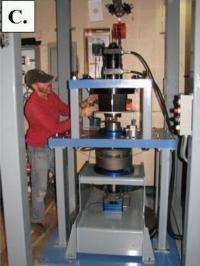October 5, 2012 report
Researchers build better earthquake simulator

(Phys.org)—Traditional earthquake simulators have generally functioned by pressing two pieces of rock material together at high pressure until they reach a breaking point, resulting in something similar to the sticking and sliding of real earthquakes. The problem with this approach, of course, is that because of the difference in scale, it's not clear if the model can be used to accurately represent real events. For this reason, researchers from the University of Oklahoma and the U.S. Geological Survey tried a new approach, pressing a piece of granite against a rotating flywheel. As described in a paper published in the journal Science, the researchers discovered that the resulting energy densities compared closely with results from measurements of real earthquakes.
Real earthquakes generally occur when the pressure between geological plates pressing against one another reaches a "breaking point." But, because each plate is interfering with the other's movement, one invariably slides beneath the other in a slipping and catching process which results in the ground above undulating in an unpredictable fashion. Creating models with the same effects allows researchers to better understand the whole process, and allows urban planners to build better, more earthquake-proof structures. Unfortunately, most models haven't been able to produce the huge energy release found in real earthquakes.
In this new effort, the research team attempted to replicate a massive energy burst onto a sample of rock, rather than the slow crushing energy generally replicated. To make this happen, they attached a clutch to a 500-pound flywheel that, at a set point, grabbed a large piece of disk-shaped granite and pressed it against the flywheel. The pressing caused energy to be quickly transferred to the granite, making it spin. This configuration more faithfully represents the events of real earthquakes, the researchers suggest, because it allows for the sudden transfer of energy into rock that happens when the breaking point is reached.
In review of their research results, the team found similarities between the characteristics of the granite disks, and rock samples taken from earthquake fault areas, thereby suggesting that their experiment closely emulated what happens to rock in earthquake zones. They also found that by varying the flywheel speed they could create earthquake simulations for various magnitudes ranging from four to eight.
More information: Rapid Acceleration Leads to Rapid Weakening in Earthquake-Like Laboratory Experiments, Science 5 October 2012: Vol. 338 no. 6103 pp. 101-105. DOI: 10.1126/science.1221195
ABSTRACT
After nucleation, a large earthquake propagates as an expanding rupture front along a fault. This front activates countless fault patches that slip by consuming energy stored in Earth's crust. We simulated the slip of a fault patch by rapidly loading an experimental fault with energy stored in a spinning flywheel. The spontaneous evolution of strength, acceleration, and velocity indicates that our experiments are proxies of fault-patch behavior during earthquakes of moment magnitude (Mw) = 4 to 8. We show that seismically determined earthquake parameters (e.g., displacement, velocity, magnitude, or fracture energy) can be used to estimate the intensity of the energy release during an earthquake. Our experiments further indicate that high acceleration imposed by the earthquake's rupture front quickens dynamic weakening by intense wear of the fault zone.
Journal information: Science
© 2012 Phys.org

















